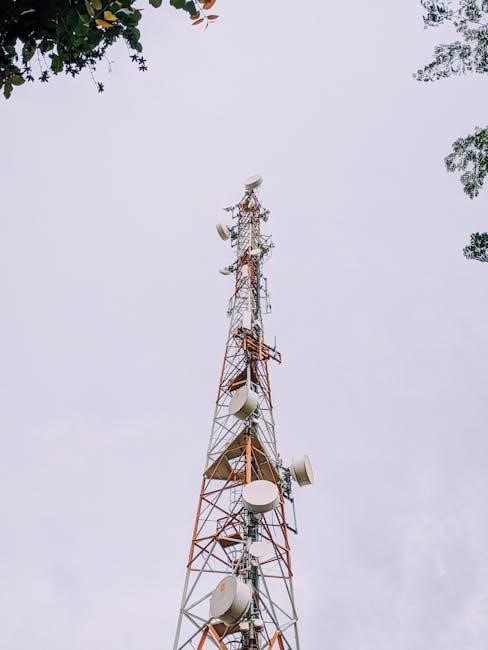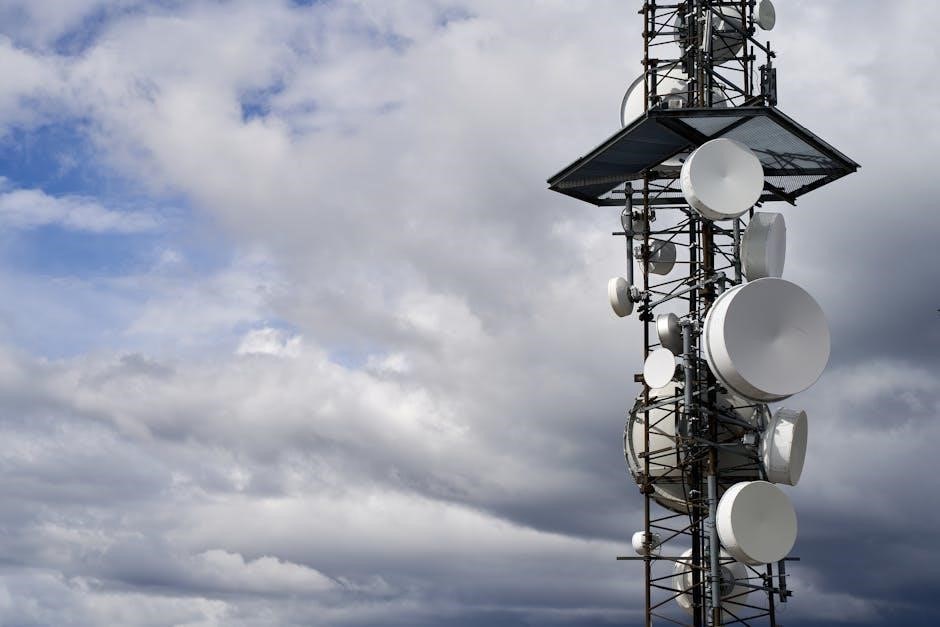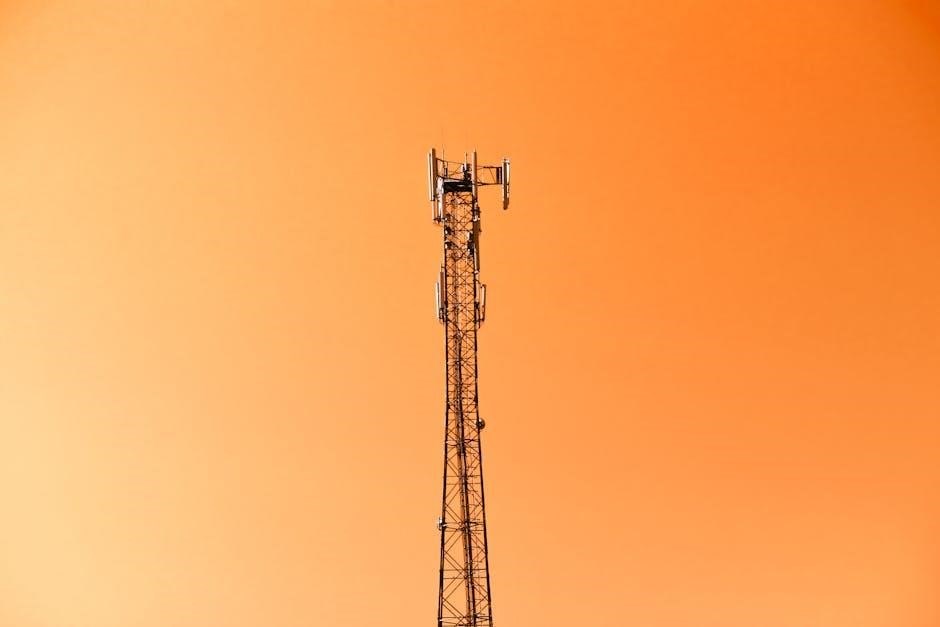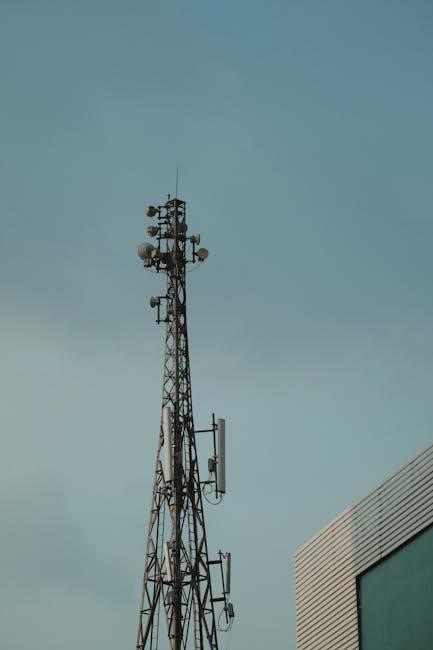Cell phone towers, or cell sites, are vital for wireless communication, consisting of antennas, transceivers, and supporting structures. These components ensure reliable signal transmission and network coverage.

1.1 Overview of Cell Phone Tower Structure
A cell phone tower, or cell site, typically consists of a tall structure, antennas, transceivers, and supporting equipment. The tower itself serves as the base, often made of steel or concrete, designed to support the weight of the antennas and withstand environmental factors like wind and rain. Antennas are mounted at strategic heights to ensure optimal signal coverage, while transceivers and base station equipment are housed near the base or in adjacent shelters. Power supplies, cooling systems, and backup generators are also essential components to maintain continuous operation. The structure is designed to elevate antennas for maximum signal propagation, ensuring reliable wireless communication over a broad area. This setup enables seamless connectivity for mobile devices, supporting voice, data, and internet services.
1.2 Importance of Tower Components in Wireless Communication
Cell phone tower components are crucial for enabling reliable wireless communication. The tower structure elevates antennas to optimal heights, ensuring signals cover extensive areas. Antennas transmit and receive radio frequencies, connecting devices to the network. Transceivers process data, managing voice calls, texts, and internet traffic. Backup systems, like generators and cooling units, maintain operation during power outages or extreme heat. These components collectively ensure uninterrupted connectivity, supporting modern communication needs. Their proper functioning is essential for seamless voice, data, and internet services, making them indispensable in today’s connected world.
Major Parts of a Cell Phone Tower
A cell phone tower comprises the tower structure, antennas, transceivers, and base station equipment, each playing a vital role in wireless communication networks.

2.1 The Tower Itself
The tower is the foundational structure of a cell phone tower, designed to support antennas, transceivers, and other essential equipment. Typically constructed from steel or concrete, it is engineered for durability and stability, ensuring it can withstand environmental factors like wind and extreme weather. The height of the tower is critical, as it determines the coverage area and signal strength. Towers can vary in design, with lattice, monopole, and guyed towers being common types. Each design serves specific purposes, such as blending into urban landscapes or providing maximum structural support in remote areas. The tower’s strength and height are carefully calculated to accommodate the weight of equipment and ensure optimal wireless communication performance. Its design and placement are pivotal in maintaining reliable network connectivity for users.
2.2 Antennas and Their Types
Antennas are crucial components of cell phone towers, responsible for transmitting and receiving radio frequency signals. They are mounted on the tower and come in various types, each designed for specific functionalities. Directional antennas, such as sector antennas, focus signals in particular directions to cover targeted areas, while omnidirectional antennas provide 360-degree coverage. Dipole antennas are simple and widely used for their reliability, whereas parabolic antennas offer high gain for long-distance communication. The choice of antenna type depends on the desired coverage area, signal strength, and network requirements. Proper alignment and configuration of antennas ensure optimal performance, minimizing interference and maximizing connectivity for users. They play a vital role in maintaining seamless communication and are essential for the efficient operation of cellular networks.
2.3 Transceivers and Base Station Equipment

Transceivers and base station equipment are the brain of cell phone towers, enabling communication between mobile devices and the broader network. Transceivers handle the conversion of voice, data, and signals between radio frequencies and digital formats. They are paired with base stations, which manage signal processing, amplification, and distribution. Together, these components ensure seamless connectivity, handling incoming and outgoing calls, texts, and data. Base stations are typically housed in shelters or cabinets at the base of the tower, while transceivers are often located near the antennas. Their combined role is critical for maintaining network reliability, signal strength, and coverage. Advanced equipment supports modern technologies like 5G, ensuring high-speed and low-latency communication. Regular maintenance of these components is essential to uphold service quality and user experience.

Technical Specifications of Tower Components
Technical specifications include frequency range, power handling, antenna gain, and coverage area. These parameters ensure optimal performance, signal strength, and reliability for wireless communication networks.
3.1 Frequency and Power Handling Capacity
The frequency range of cell phone towers typically spans from 600 MHz to 2.6 GHz, accommodating various wireless technologies like 4G and 5G. Power handling capacity refers to the maximum radio frequency (RF) power that antennas and transceivers can manage without degradation. This capacity ensures stable signal transmission across the network. Higher frequencies offer greater bandwidth, enabling faster data rates, while lower frequencies provide better penetration through obstacles. The balance between frequency and power is crucial for maintaining coverage and minimizing interference. Operators must adhere to regulatory limits to ensure RF radiation remains within safe levels for public exposure. Understanding these specifications is essential for optimizing network performance and reliability.
3.2 Antenna Gain and Coverage Area
Antenna gain, measured in decibels (dBi), determines how effectively a cell tower concentrates signal strength in a specific direction. Higher gain antennas focus signals more precisely, enhancing coverage over longer distances. Coverage area depends on antenna gain, frequency, and power output. Lower frequencies, like 600 MHz, typically cover larger areas, while higher frequencies, such as 2.6 GHz, offer faster data rates but shorter range. Modern cell towers often use high-gain antennas (10dBi to 22dBi) to balance coverage and capacity. Environmental factors, such as terrain and obstructions, also influence the effective coverage area. Proper antenna configuration ensures optimal signal distribution, minimizing dead zones and interference. This balance is critical for delivering reliable wireless communication across diverse landscapes and populations.

Safety and Regulatory Considerations
Cell towers must adhere to strict RF radiation exposure limits and structural safety standards to ensure public health and compliance with regulatory requirements.
4.1 RF Radiation Safety Standards
RF radiation safety standards for cell towers are established to protect the public and workers from excessive exposure. Regulatory bodies like the FCC and ICNIRP set strict limits on radiation levels. These standards ensure that emissions remain well below thresholds deemed safe for human health. RF exposure is measured in terms of power density, typically expressed in watts per square meter. Compliance is verified through regular testing and monitoring of tower emissions. Public concern about RF radiation has led to rigorous enforcement of these standards. The guidelines also account for long-term exposure scenarios, ensuring that even prolonged proximity to towers poses no health risks. By adhering to these standards, cell towers operate safely within designated limits, balancing network reliability with public safety.
4.2 Structural Safety and Compliance
Structural safety and compliance are critical to ensure cell towers withstand environmental stresses and operational demands. Towers are designed using robust engineering principles, with materials like steel and concrete chosen for durability. Regular inspections and maintenance are mandatory to prevent structural failure. Compliance involves adherence to local building codes, zoning laws, and industry standards, such as those set by the Telecommunications Industry Association (TIA). Towers must also meet seismic and wind resistance requirements, particularly in prone areas. Additionally, environmental impact assessments are conducted to ensure minimal disruption to ecosystems. Proper grounding and lightning protection systems are installed to safeguard against electrical hazards. These measures ensure that cell towers are structurally sound, reliable, and compliant with safety regulations, balancing public safety with network performance. Compliance also extends to operational aspects, ensuring towers are accessible for maintenance and upgrades.

Environmental Impact and Mitigation
Cell towers can impact ecosystems through land use and emissions. Mitigation strategies include using renewable energy sources, minimizing physical footprints, and employing camouflage designs to blend with surroundings.
5.1 Environmental Considerations for Tower Placement
Cell phone towers must be strategically placed to minimize ecological disruption. Key considerations include proximity to wildlife reserves, wetlands, and protected areas. Local regulations often dictate setbacks from sensitive ecosystems to prevent habitat destruction. Additionally, towers should avoid locations that could disrupt migratory bird patterns or interfere with natural landscapes. Visual impact is another factor, with towers sometimes being camouflaged to blend into surroundings. Communities may also voice concerns about tower placement, emphasizing the need for public consultation. Finally, operators aim to use existing infrastructure, such as rooftops or utility poles, to reduce the need for new constructions. These strategies help balance network expansion with environmental preservation, ensuring connectivity while safeguarding natural resources and communities.
5.2 Strategies for Minimizing Ecological Footprint
To minimize the ecological footprint of cell phone towers, operators adopt several strategies. One approach is using renewable energy sources, such as solar or wind power, to reduce reliance on fossil fuels. Energy-efficient equipment and smart power management systems are also employed to lower overall energy consumption. Additionally, tower sharing among multiple providers reduces the number of structures needed, preserving natural habitats. Materials used in construction are often selected for durability and recyclability to minimize waste. Noise reduction technologies are implemented to avoid disrupting wildlife. Regular maintenance ensures equipment operates efficiently, preventing unnecessary environmental impact. By integrating these practices, the telecommunications industry can expand connectivity while maintaining a commitment to environmental sustainability and reducing its ecological footprint.
